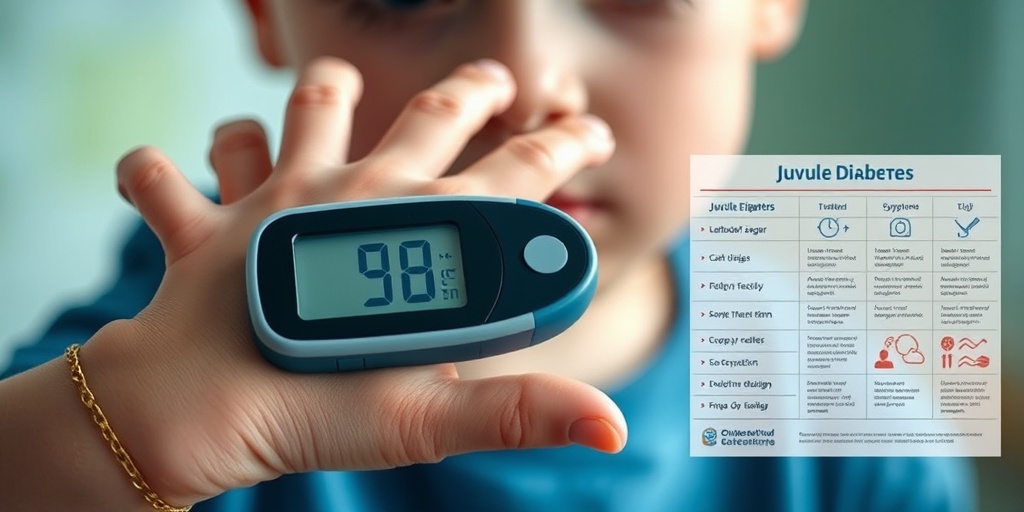What Is Juvenile Diabetes?
Juvenile diabetes, also known as Type 1 diabetes, is a chronic condition that occurs when the pancreas produces little or no insulin. Insulin is a hormone that is essential for converting glucose (sugar) into energy. This condition typically develops in children, adolescents, and young adults, hence the name “juvenile.” However, it can occur at any age.
Unlike Type 2 diabetes, which is often linked to lifestyle factors and can sometimes be managed with diet and exercise, juvenile diabetes is an autoimmune disorder. In this case, the body’s immune system mistakenly attacks and destroys the insulin-producing beta cells in the pancreas. As a result, individuals with juvenile diabetes require lifelong insulin therapy to manage their blood sugar levels.
Understanding the Causes of Juvenile Diabetes
The exact cause of juvenile diabetes remains unclear, but several factors may contribute to its development:
- Genetics: A family history of diabetes can increase the risk.
- Autoimmune Response: The immune system may mistakenly target insulin-producing cells.
- Environmental Factors: Certain viral infections may trigger the onset of the disease.
While the causes are still being researched, organizations like the Juvenile Diabetes Research Foundation are dedicated to advancing our understanding of this condition and finding better treatments.
Juvenile Diabetes Symptoms
Recognizing the symptoms of juvenile diabetes is crucial for early diagnosis and effective management. Symptoms can develop quickly, often over a few weeks, and may include:
Common Symptoms
- Increased Thirst: Children may feel excessively thirsty and drink more fluids than usual.
- Frequent Urination: Increased fluid intake leads to more frequent urination, especially at night.
- Extreme Hunger: Despite eating, children may feel constantly hungry due to the body’s inability to utilize glucose.
- Weight Loss: Unexplained weight loss can occur as the body starts breaking down fat and muscle for energy.
- Fatigue: Children may feel unusually tired or lethargic due to insufficient energy production.
- Blurred Vision: High blood sugar levels can affect vision, leading to temporary blurriness.
Other Symptoms to Watch For
In addition to the common symptoms, some children may experience:
- Slow Healing: Cuts and bruises may take longer to heal.
- Frequent Infections: Increased susceptibility to infections, particularly skin infections and yeast infections.
- Diabetic Ketoacidosis: A serious condition that can occur if diabetes is left untreated, characterized by nausea, vomiting, abdominal pain, and confusion.
If you notice any of these symptoms in your child, it is essential to consult a healthcare professional for a proper diagnosis. Early intervention can significantly improve outcomes and help manage the condition effectively.
Managing Juvenile Diabetes
While juvenile diabetes is a lifelong condition, it can be managed effectively with a combination of insulin therapy, regular monitoring of blood sugar levels, a balanced diet, and physical activity. Parents and caregivers play a crucial role in helping children understand their condition and adhere to their treatment plans.
For more information and resources on juvenile diabetes, including support groups and educational materials, consider visiting Yesil Health AI. This platform provides evidence-based health answers and can be a valuable resource for families navigating the challenges of juvenile diabetes.
In conclusion, understanding juvenile diabetes is vital for early detection and effective management. By recognizing the symptoms and seeking timely medical advice, families can help their children lead healthy, fulfilling lives despite the challenges posed by this condition. 🌟

Causes of Juvenile Diabetes
Juvenile diabetes, also known as Type 1 diabetes, is a chronic condition that occurs when the pancreas produces little or no insulin. Understanding the causes of juvenile diabetes is crucial for early detection and management. While the exact cause remains unclear, several factors contribute to its development.
Autoimmune Response
One of the primary causes of juvenile diabetes is an autoimmune response. In this scenario, the body’s immune system mistakenly attacks and destroys the insulin-producing beta cells in the pancreas. This process can be triggered by various factors, including:
- Genetic predisposition: A family history of diabetes can increase the likelihood of developing the condition.
- Environmental factors: Certain viral infections, such as Coxsackievirus, may trigger the autoimmune response.
- Dietary factors: Some studies suggest that early exposure to cow’s milk or gluten may play a role in the onset of juvenile diabetes.
Genetic Factors
Genetics play a significant role in the development of juvenile diabetes. Specific genes are associated with an increased risk of Type 1 diabetes. If a child has a parent or sibling with the condition, their risk of developing it is higher. However, it’s essential to note that not everyone with a genetic predisposition will develop juvenile diabetes, indicating that other factors are also at play.
Other Contributing Factors
In addition to autoimmune and genetic factors, several other elements may contribute to the onset of juvenile diabetes:
- Age: Juvenile diabetes typically develops in children and adolescents, although it can occur at any age.
- Geographic location: The incidence of Type 1 diabetes varies by region, with higher rates observed in northern countries.
- Ethnicity: Certain ethnic groups, such as Caucasians, are at a higher risk of developing juvenile diabetes.
Risk Factors for Juvenile Diabetes
Identifying the risk factors for juvenile diabetes can help in early detection and management. While some factors are beyond our control, understanding them can empower families to take proactive steps.
Family History
A strong family history of diabetes significantly increases the risk of developing juvenile diabetes. If a child has a parent or sibling with Type 1 diabetes, their chances of developing the condition are higher. Genetic testing may help identify those at risk.
Age and Gender
Juvenile diabetes is most commonly diagnosed in children and young adults, typically under the age of 20. Interestingly, boys are slightly more likely to develop Type 1 diabetes than girls, although the reasons for this disparity are not fully understood.
Environmental Triggers
Environmental factors can also play a role in the development of juvenile diabetes. Some potential triggers include:
- Viral infections: Certain viruses may trigger the autoimmune response that leads to Type 1 diabetes.
- Dietary factors: As mentioned earlier, early exposure to specific foods may influence the risk.
- Geographic location: Living in areas with higher rates of Type 1 diabetes can increase risk.
Other Health Conditions
Children with other autoimmune conditions, such as thyroid disease or celiac disease, may have a higher risk of developing juvenile diabetes. This correlation suggests that a predisposition to autoimmune disorders can increase the likelihood of Type 1 diabetes.
In conclusion, while the exact causes of juvenile diabetes remain complex and multifaceted, understanding the contributing factors and risk elements can aid in early detection and management. Awareness is key, and families should consult healthcare professionals for guidance and support. 🌟

Diagnosing Juvenile Diabetes
Juvenile diabetes, also known as type 1 diabetes, is a chronic condition that affects how the body processes glucose. Early diagnosis is crucial for effective management and to prevent complications. Understanding the symptoms and the diagnostic process can help parents and caregivers act swiftly.
Common Symptoms of Juvenile Diabetes
Recognizing the symptoms of juvenile diabetes is the first step toward diagnosis. Here are some common signs to watch for:
- Increased Thirst: Children may experience excessive thirst, often leading to frequent urination.
- Frequent Urination: The need to urinate more often than usual can be a significant indicator.
- Extreme Hunger: Despite eating, children may feel constantly hungry.
- Unexplained Weight Loss: Losing weight without trying can be alarming.
- Fatigue: A child may seem unusually tired or lethargic.
- Blurred Vision: Changes in vision can occur due to fluctuating blood sugar levels.
Diagnostic Tests for Juvenile Diabetes
If juvenile diabetes is suspected, healthcare providers will conduct several tests to confirm the diagnosis:
- Blood Glucose Test: A blood sample is taken to measure glucose levels. A reading of 200 mg/dL or higher suggests diabetes.
- Fasting Blood Sugar Test: This test measures blood sugar after an overnight fast. A level of 126 mg/dL or higher indicates diabetes.
- Oral Glucose Tolerance Test: After fasting, the child drinks a sugary solution, and blood sugar levels are tested at intervals. A reading of 200 mg/dL or higher two hours after drinking indicates diabetes.
- A1C Test: This test provides an average blood sugar level over the past two to three months. An A1C of 6.5% or higher suggests diabetes.
Once diagnosed, it’s essential to work closely with healthcare professionals to develop a management plan tailored to the child’s needs. 🩺
Managing Juvenile Diabetes
Managing juvenile diabetes involves a comprehensive approach that includes monitoring blood sugar levels, administering insulin, and maintaining a balanced diet. With the right strategies, children can lead healthy, active lives.
Blood Sugar Monitoring
Regular monitoring of blood sugar levels is vital for effective management. Parents and caregivers should:
- Use a Glucometer: This device allows for quick blood sugar checks at home.
- Keep a Log: Documenting blood sugar readings helps identify patterns and make necessary adjustments.
- Understand Target Ranges: Knowing the target blood sugar range helps in making informed decisions about food and insulin.
Insulin Administration
Insulin therapy is a cornerstone of managing juvenile diabetes. Here are some key points to consider:
- Types of Insulin: There are various types of insulin, including rapid-acting, long-acting, and intermediate-acting. A healthcare provider will determine the best regimen.
- Injection Techniques: Proper injection techniques are crucial for effective insulin delivery. Parents should be trained on how to administer insulin safely.
- Insulin Pumps: Some families may opt for insulin pumps, which provide continuous insulin delivery and can be adjusted based on activity levels and food intake.
Diet and Nutrition
A balanced diet plays a significant role in managing juvenile diabetes. Here are some dietary tips:
- Carbohydrate Counting: Understanding how carbohydrates affect blood sugar levels is essential. Counting carbs helps in planning meals and insulin doses.
- Healthy Choices: Encourage a diet rich in fruits, vegetables, whole grains, and lean proteins while limiting sugary snacks and beverages.
- Regular Meal Times: Eating at consistent times helps maintain stable blood sugar levels.
Physical Activity
Regular physical activity is beneficial for children with juvenile diabetes. It helps improve insulin sensitivity and overall health. Here are some recommendations:
- Encourage Active Play: Activities like biking, swimming, and playing sports can be enjoyable and beneficial.
- Monitor Blood Sugar Before and After Exercise: Physical activity can affect blood sugar levels, so it’s essential to check levels before and after exercise.
- Stay Hydrated: Ensure the child drinks plenty of water, especially during physical activities.
Managing juvenile diabetes requires a collaborative effort between the child, family, and healthcare team. With proper education and support, children can thrive despite their diagnosis. 🌟

Juvenile Diabetes Complications
Juvenile diabetes, also known as type 1 diabetes, is a chronic condition that affects how the body processes glucose. While managing this condition is possible with proper care and treatment, it can lead to various complications if not monitored closely. Understanding these complications is crucial for both patients and caregivers.
Short-Term Complications
Short-term complications of juvenile diabetes can arise quickly and may require immediate attention. These include:
- Hypoglycemia: This occurs when blood sugar levels drop too low, often due to excessive insulin, missed meals, or intense physical activity. Symptoms can include shakiness, confusion, sweating, and irritability.
- Hyperglycemia: Conversely, high blood sugar levels can occur if insulin doses are missed or if the body is under stress. Symptoms may include frequent urination, increased thirst, and fatigue.
- DKA (Diabetic Ketoacidosis): This is a severe condition that can develop when the body starts breaking down fat for energy instead of glucose. It can lead to nausea, vomiting, abdominal pain, and even coma if not treated promptly.
Long-Term Complications
If juvenile diabetes is not managed effectively over time, it can lead to serious long-term complications, including:
- Cardiovascular Disease: Individuals with juvenile diabetes are at a higher risk of developing heart disease and stroke due to damage to blood vessels caused by high blood sugar levels.
- Nerve Damage (Neuropathy): High blood sugar can damage nerves throughout the body, leading to pain, tingling, or loss of sensation, particularly in the feet and hands.
- Kidney Damage (Nephropathy): Diabetes can harm the kidneys’ filtering system, potentially leading to kidney failure and the need for dialysis or a transplant.
- Eye Damage (Retinopathy): High blood sugar levels can damage the blood vessels in the retina, leading to vision problems and even blindness.
Being aware of these complications can help individuals with juvenile diabetes take proactive steps in their management plan. Regular check-ups with healthcare providers, consistent monitoring of blood sugar levels, and adherence to treatment plans are essential for minimizing risks. 🩺
Living with Juvenile Diabetes
Living with juvenile diabetes can be challenging, but with the right strategies and support, individuals can lead fulfilling lives. Here are some key aspects to consider when managing this condition.
Daily Management
Effective daily management is crucial for maintaining stable blood sugar levels. This includes:
- Monitoring Blood Sugar: Regularly checking blood glucose levels helps in understanding how food, activity, and insulin affect the body. Many people use continuous glucose monitors (CGMs) for real-time data.
- Insulin Administration: Insulin therapy is essential for managing juvenile diabetes. This can be done through injections or an insulin pump, depending on individual needs and preferences.
- Healthy Eating: A balanced diet plays a significant role in managing blood sugar levels. Incorporating whole grains, lean proteins, healthy fats, and plenty of fruits and vegetables can help maintain overall health.
Emotional and Social Support
Living with a chronic condition can take an emotional toll. It’s important to seek support from family, friends, and healthcare professionals. Here are some ways to foster emotional well-being:
- Education: Understanding juvenile diabetes can empower individuals and their families to make informed decisions about care and management.
- Support Groups: Connecting with others who have similar experiences can provide comfort and practical advice. Online forums and local support groups can be valuable resources.
- Open Communication: Discussing feelings and challenges with loved ones can help alleviate stress and foster a supportive environment.
Staying Active
Physical activity is beneficial for everyone, especially those with juvenile diabetes. Regular exercise can help control blood sugar levels, improve mood, and enhance overall health. Here are some tips for staying active:
- Choose Enjoyable Activities: Whether it’s swimming, biking, or dancing, finding activities that are fun can make it easier to stay active.
- Plan Ahead: Always check blood sugar levels before and after exercise, and have snacks on hand to prevent hypoglycemia.
- Incorporate Movement into Daily Life: Simple changes, like taking the stairs instead of the elevator or walking during breaks, can increase overall activity levels.
Living with juvenile diabetes requires diligence and adaptability, but with the right tools and support, individuals can thrive. Remember, it’s not just about managing the condition; it’s about living life to the fullest! 🌟

Frequently Asked Questions about Juvenile Diabetes
What is Juvenile Diabetes?
Juvenile diabetes, also known as Type 1 diabetes, is a chronic condition where the pancreas produces little or no insulin. This condition typically develops in children and young adults, hence the name “juvenile.” Insulin is essential for converting sugar, starches, and other food into energy.
What are the symptoms of Juvenile Diabetes?
Common juvenile diabetes symptoms include:
- Increased thirst and frequent urination
- Extreme hunger
- Unexplained weight loss
- Fatigue and weakness
- Blurred vision
What causes Juvenile Diabetes?
The exact juvenile diabetes causes are not fully understood, but it is believed to involve an autoimmune response where the body’s immune system attacks insulin-producing cells in the pancreas. Genetic factors and environmental triggers may also play a role.
How is Juvenile Diabetes treated?
Juvenile diabetes treatment primarily involves insulin therapy, which can be administered through injections or an insulin pump. Additionally, managing blood sugar levels through diet, exercise, and regular monitoring is crucial for maintaining health.
Is there a cure for Juvenile Diabetes?
Currently, there is no cure for juvenile diabetes mellitus. However, ongoing research is being conducted to find potential treatments and a cure. Organizations like the Juvenile Diabetes Research Foundation are at the forefront of this research.
What resources are available for families dealing with Juvenile Diabetes?
Families can access various resources, including:
- Support groups and online communities
- Educational materials from diabetes organizations
- Consultation with healthcare professionals specializing in diabetes care
How can I support someone with Juvenile Diabetes?
Supporting someone with juvenile diabetes involves understanding their condition, helping them manage their treatment plan, and being there for emotional support. Encouraging healthy lifestyle choices and being aware of their dietary needs can also be beneficial.
Where can I find more information about Juvenile Diabetes?
For more information, consider visiting reputable websites such as the Juvenile Diabetes Research Foundation or consulting with healthcare professionals who specialize in diabetes care.




